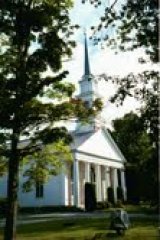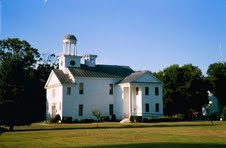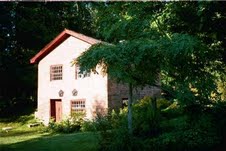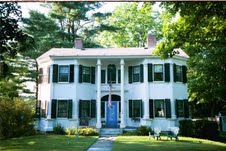Other Historical Buildings
Castleton Federated Church

Master builder Thomas Dake built the Castleton Federated Church in 1833. Its most magnificent feature is the pulpit. History has it that he ran short of funds. When he approached the church committee about more money, he was turned down. Dake paid for the completion of the church and pulpit out of his own pocket.
A unique feature of the church is the fact that the congregation faces forward, toward the main entrances to the sanctuary. Also, the building was built to hold a cedar shingle roof. Although now fitted with a slate roof, the extra weight of the stone roof causes the roofline walls to bulge slightly.
The Castleton Federated Church is recorded in the Historic American Buildings Survey which is now a part of the collection at the Library of Congress. The online catalog entry contains several nice photographs of both the exterior of the church and the pulpit. Type Castleton Federated Church into the search field.
Castleton Medical Chapel

Castleton Medical College Chapel was built in 1821 and still stands today on the campus of Castleton State College. Castleton Medical College, established in 1818, was one of the first nine medical colleges in the United States. In that year, Drs. Selah Gridley and Theodore Woodward, in addition to seeing to a busy practice in Castleton, established the “Castleton Medical Academy” along with Thomas Cazier, when they found that they had more apprentice applicants than they could teach. None of the three men who established the college held medical degrees. By the time the Castleton Medical College closed in 1862, about 1,400 men had earned medical degrees there, more than any of the other seven medical schools in New England.
Drs. Gridley and Woodward bought the original Medical College building in 1818 when they opened the Academy. By 1821 there were enough students enrolled to warrant the building of a new structure. The first floor of the new building, the current Castleton Medical Chapel, originally housed a lecture room, laboratory, study, and library. The second floor held a dissecting room and an “anatomical theater” with a skylight and reached by way of a winding staircase.
The building that is now called the Old Chapel has been moved around town several times, most recently onto the college campus. In 1968 it was completely renovated and is used by the college for a variety of educational and community purposes.
The Old Cobbler Shop

Possibly the oldest brick structure in Vermont, The Old Cobbler shop was acquired by the Castleton Historical Society in 1947 and turned into their first museum in 1954. Located at the corner of Main Street and Cemetery Street, The Old Cobbler Shop stands on a corner of a piece of land that Zadock Remington bought from Amos Bird in 1769. Remington’s Tavern was located further west on this piece of land. David and Zadock Remington sold 6 ¾ acres of their land to Nehemiah Hoyt in 1774. Nehemiah Hoyt in his turn, sold it to Enos Merrill in 1794 by which time this small brick building had been erected which Enos Merrill used for a tannery and cobbler’s shop.
Langdon-Hitchcock House

The Langdon-Hitchcock House is considered to be master builder Thomas Dake’s masterpiece. It was built in 1823 for B. F. Langdon on property that he had purchased from his father, Chauncey Langdon. It is one of two houses in Vermont with two-story room-width bay windows flanking the central hall. Of special interest outside the house are the wall pilasters, Palladian window, entry fanlight and entry columns. Of special interest inside the house is the “Dake staircase”, Thomas Dake’s signature structural component. The house is listed on the Historic American Buildings Survey, which resides in the Library of Congress. There is a photograph of the staircase in the Library of Congress’ digitized collection.
